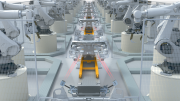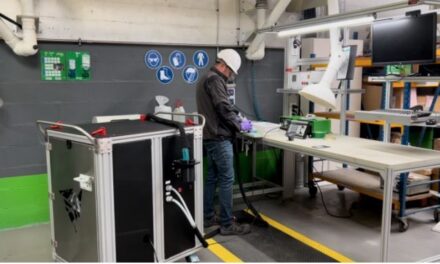A machine vision innovation for automotive robotic cells from SICK has dramatically reduced the production time and costs associated with body positioning on car production lines.
The SICK BPS5400 Body Positioning System is a non-contact vision system for car body positioning on skid-carrier based lines. The system won an Automotive Engineering Exposition Innovation Award in Nuremberg in June last year.
Conventional positioning systems in robot cells, used by OEMs all over the world, work with mechanical substructure clamping technology, consisting of a lifting table, guiding pins and clamps. The conventional technology uses the RPS (Reference Point System) to position the car body in the robot workstation cell. The car body is positioned/centered mechanically by lowering the RPS holes in the car chassis over guiding pins. This aligns the car body with robot cell coordinate system and a mechanical clamping device is then used to hold it in position.
Non-Contact Vision Solution
The SICK BPS5400 system was developed, initially with Skoda, as the OEM was looking for a non-contact vision solution to reduce both the production costs and risks of using a mechanical system. The mechanical system has significant disadvantages: It is vulnerable to damage, requires power, takes up space and it takes time for the chassis to be lowered and then raised again in and out of the workstation. Using the SICK non-contact system, a reduction can be seen in production cycle times; an average of 5% has been shown for operations such as spot welding, gluing, etc, as well as opening up the opportunity to more easily accommodate different car chassis types moving along on the same lines. The system has the potential to be used for many types of robot cells, e.g. for respot welding, glue inspection, stud welding, quality inspection, and even for load positioning on AGVs.
The SICK BPS5400 is a 3D system based on four SICK Inspector P654 programmable 2D cameras with laser triangulation used to gain the 3rd dimension. Initial test data has shown it can achieve a highly accurate measurement of the body position with 99.996% localisation rates.
The SICK BPS5400 is used to calculate the 3D position coordinates for precise robot guidance. The cameras are ‘trained’ on certain parts of the car chassis (this could either be the RPS hole or other features). The system finds those features and then combines and compares the data with the pre-taught position data. From this it can then calculate the offset from the pre-taught co-ordinates, so that an accurate position can be sent to the robots.
The key to the effectiveness of the system is the way the system uses laser triangulation to calculate the precise position. A 2D image ascertains the x/y position, then a second image of a laser line projected over the reference area is used to calculate the z axis, and therefore any tilt or pan etc.
This is a complete stand-alone solution developed in SICK’s AppSpace software development platform. Each BSP unit comprises a 4 pre-fabricated camera/laser modules, electrical cabinet and optional HMI plus all cables and connectors ready for easy installation on site. It can be retrofitted onto existing lines. The BPS System has built in redundancy and has been shown to work effectively with three cameras providing the x, y, z body location without any loss of accuracy or reliability.
An optional measurement device based on the SICK Inspector P632 can be added to measure body movement during welding.
Industry 4.0 benefits
As a non-contact, non-mechanical system, the SICK BPS offers OEMs much more flexibility to introduce a greater variety of car body types onto the same line without needed to make physical changes. Production flexibility and the opportunity to achieve smaller production runs and more customised products is a key objective of Industry 4.0. This could also offer OEMs cost-savings in future to accommodate greater variety as more electric car chassis enter production.
Another I 4.0 benefit is the ability to collect, interrogate and interpret data from the system. Data from the BPS system is transferred via a SICK Telematic Data Collector and stored in the cloud and can be viewed via the web-server dashboard or uploaded for integration into a factory management system. It can also be exported for viewing on local servers, HMI panels or PCs. The system provides a production log, including saved images and other useful information. Using the system SICK has typically logged a highly accurate measurement of the body position with 99.996% localisation rates
Data on the system performance, e.g. the status of the cameras, is collected and monitored in real time. Receiving data from the system aids predictive, preventative maintenance and any production failures can be detected quickly. For example, right from the start, the system provides data on how well the chassis is being positioned. So, let’s say, for example, the system shows that the chassis is starting to be positioned a little further back than usual, then this could be an indicator of a problem with the conveyor drive chain, so an action needs to be taken. By analysing production trends, the system can ensure optimum production efficiency in real time. It can be set up to detect motion of the car body, and therefore prevent damage to the body or robots during welding or other body operations. The system can be interrogated on demand for analytics about both production efficiency and the system performance.
Power Consumption
 Using the system saves significantly on power demand and costs. There’s no need for lifting and fewer motors are needed. So, using the system across multiple cells (e.g. replacing 50 lifts across a line) offers a significant reduction in electricity costs and consequent CO2 emissions.
Using the system saves significantly on power demand and costs. There’s no need for lifting and fewer motors are needed. So, using the system across multiple cells (e.g. replacing 50 lifts across a line) offers a significant reduction in electricity costs and consequent CO2 emissions.
With significantly less weight than a mechanical solution, using a vision system is also much less demanding in terms of installation e.g. for second floor conveyor lines.
For more information please contact Andrea Hornby on 01727 831121 or email andrea.hornby@sick.co.uk.

